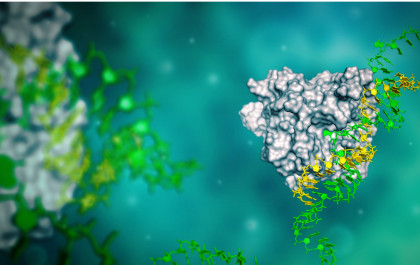ProQR Doses First LCA 10 Patient in Clinical Trial of QR-110, ProQR’s Lead Program for Genetic Blindness
Key Updates
- The first patient has received the first dose of QR-110 in the Phase 1/2 safety & efficacy clinical trial (PQ-110-001: NCT03140969) in children and adults with Leber’s congenital amaurosis 10 (LCA 10).
- LCA 10 is one of the most prevalent forms of gene-related blindness in children worldwide and currently there are no therapies commercially available or in clinical development for this disease.
- QR-110 has received fast track designation by the U.S. Food and Drug Administration (FDA) and has been granted orphan drug designation in the United States and European Union.
- Interim safety and efficacy trial results from the majority of patients after 6 months of treatment are expected in 2018, full 12 month treatment data from all patients are expected in 2019.
LEIDEN, the Netherlands, Nov. 13, 2017 (GLOBE NEWSWIRE) -- ProQR Therapeutics N.V. (Nasdaq:PRQR) today announced that the first patient has been dosed in the Phase 1/2 open-label trial assessing the safety, tolerability, pharmacokinetics and efficacy of QR-110. The trial will enroll approximately six adults and six children who have Leber’s congenital amaurosis 10 (LCA 10) due to the p.Cys998X mutation in the CEP290 gene. Subjects will receive a dose of QR-110 every three months for a total of four doses in one eye. The trial is planned to be conducted at three specialized centers: the University of Iowa, Iowa City, IA, US, the Scheie Eye Institute at the University of Pennsylvania, Philadelphia, PA, US and the Ghent University Hospital, Ghent, Belgium.
Benjamin Yerxa, PhD., Chief Executive Officer at Foundation Fighting Blindness, stated, “We are delighted with the launch of ProQR’s clinical trial for its treatment for people with devastating vision loss caused by the p.Cys998X mutation in CEP290. There are no other options for these patients, and furthermore, we believe most emerging gene replacement technologies do not have the capacity to deliver the large CEP290 gene to the retina.”
QR-110 is ProQR’s lead program in the ophthalmology pipeline that also includes two programs for Usher syndrome, a program for Fuchs endothelial corneal dystrophy and a program for Stargardt’s disease. QR-110 is ProQR’s second program to enter clinical development, following QR-010, which is being developed for the most common mutation causing cystic fibrosis.
“This announcement recognizes an important next step towards achieving our goal of developing precision medicines based on molecular diagnostics and our RNA therapeutic platform,” said David M. Rodman, MD, Chief Development Strategy Officer of ProQR. “The QR-110 program is the first in a planned series of ophthalmology trials utilizing our RNA therapy platform to target the underlying cause of blindness in patients with inherited forms of retinal dystrophy. We expect this trial will give us fundamental information regarding the safety, efficacy and developability of QR-110 in adults and children with LCA 10.”
Key facts on QR-110
- QR-110 aims to delay the progression of the disease or restore vision in people with LCA 10 due to the p.Cys998X mutation in the CEP290 gene.
- QR-110 is a single stranded RNA oligonucleotide designed to restore wild-type or normal CEP290 mRNA.
- In pre-clinical studies of QR-110, it was shown to convert close to 100% of the mutant mRNA to wild-type in a homozygous optic cup organoid model.
- A long half-life in the eye allowing for infrequent dosing.
- Administered through intravitreal administration, which is considered a routine procedure.
- A ProQR sponsored pre-evaluation/retrospective natural history study collecting data of 22 LCA 10 patients over a period of 16 years was completed in 2017 (Samuel G. Jacobson et al; Outcome Measures for Clinical Trials of Leber Congenital Amaurosis Caused by the Intronic Mutation in the CEP290 Gene. Invest. Ophthalmol. Vis. Sci. 2017;58(5):2609-2622.)
About the PQ-110-001 trial
PQ-110-001 is an open-label trial that will include approximately six children (age 6 - 17 years) and six adults (≥ 18 years) who have LCA 10 due to one or two copies of the p.Cys998X mutation in the CEP290 gene. During the trial, subjects will receive four intravitreal injections of QR-110 into one eye; one every three months. The QR-110 trial is expected to be conducted in three centers with significant expertise in genetic retinal disease in the US and Europe.
The objectives of the trial will include safety, tolerability, pharmacokinetics and efficacy as measured by restoration or improvement of visual function and retinal structure through ophthalmic endpoints such as visual acuity, full field stimulus testing (FST), optical coherence tomography (OCT), pupillary light reflex (PLR), mobility course and fixation stability. Changes in quality of life in the trial subjects will also be evaluated. Interim safety and efficacy trial results from the majority of patients after 6 months of treatment are expected in 2018, full 12 month treatment data from all patients in the trial are expected in 2019.
About Leber’s Congenital Amaurosis 10
Leber’s congenital amaurosis (LCA) is the most common cause of blindness due to genetic disease in children and consists of a group of diseases of which LCA 10 is the more severe forms. LCA 10 is caused by mutations in the CEP290 gene of which the p.Cys998X mutation is the most common. LCA 10 leads to early loss of vision causing most people to lose their sight in the first few years of life. To date, there are no treatments approved or other products in clinical development that treat the underlying cause of the disease. Approximately 2,000 people in the Western world have LCA 10 because of this mutation.
About QR-110
QR-110 is a first-in-class investigational RNA-based oligonucleotide designed to address the underlying cause of Leber’s congenital amaurosis 10 due to the p.Cys998X mutation in the CEP290 gene. The p.Cys998X mutation is a substitution of one nucleotide in the pre-mRNA that leads to aberrant splicing of the mRNA and non-functional CEP290 protein. QR-110 is designed to restore normal (wild-type) CEP290 mRNA leading to the production of normal CEP290 protein by binding to the mutated location in the pre-mRNA causing normal splicing of the pre-mRNA. QR-110 is intended to be administered through intravitreal injections in the eye and has been granted orphan drug designation in the United States and the European Union and received fast-track designation by the FDA.
The company presented promising pre-clinical data that supports the clinical development of QR-110 at several conferences including the Annual Meeting of the Association for Research in Vision and Ophthalmology (ARVO) in 2016 and 2017. QR-110 has demonstrated the capacity to rescue a normal mRNA and protein profile in LCA 10 patient cells carrying one or two copies of the p.Cys998X mutation. In a LCA 10 patient-derived optic cup organoid model QR-110 rescued the mRNA profile which lead to a functional CEP290 protein. It was shown that QR-110 reaches the outer nuclear layer in vivo, the target site for therapeutic action in the eye, following a single intravitreal injection.
About ProQR
ProQR Therapeutics is dedicated to changing lives through the creation of transformative RNA medicines for the treatment of severe genetic rare diseases such as cystic fibrosis, Leber’s congenital amaurosis 10 and dystrophic epidermolysis bullosa. Based on our unique proprietary RNA repair platform technologies we are growing our pipeline with patients and loved ones in mind.
*Since 2012*
FORWARD-LOOKING STATEMENTS
This press release contains forward-looking statements. All statements other than statements of historical fact are forward-looking statements, which are often indicated by terms such as “anticipate,” “believe,” “could,” “estimate,” “expect,” “goal,” “intend,” “look forward to”, “may,” “plan,” “potential,” “predict,” “project,” “should,” “will,” “would” and similar expressions. Forward-looking statements are based on management’s beliefs and assumptions and on information available to management only as of the date of this press release. These forward-looking statements include, but are not limited to, statements regarding QR-110 and the clinical development and the therapeutic potential thereof, statements regarding PQ-110-001, including trial design and expected timing of results, statements regarding orphan drug designation and Fast Track designation, and statements regarding our ongoing and planned discovery and development of product candidates and the timing thereof, including those in our innovation pipeline. Our actual results could differ materially from those anticipated in these forward-looking statements for many reasons, including, without limitation, risks associated with our clinical development activities, including that positive results observed in our prior and ongoing studies may not be replicated in later trials or guarantee approval of any product candidate by regulatory authorities, that a Fast Track designation by the FDA may not actually lead to a faster development, regulatory review or approval process, manufacturing processes and facilities, regulatory oversight, product commercialization, intellectual property claims, and the risks, uncertainties and other factors in our filings made with the Securities and Exchange Commission, including certain sections of our annual report filed on Form 20-F. Given these risks, uncertainties and other factors, you should not place undue reliance on these forward-looking statements, and we assume no obligation to update these forward-looking statements, even if new information becomes available in the future, except as required by law.
ProQR Therapeutics N.V.:
Investor and Media Contact:
Bonnie Ortega
T: +1 858 245 3983
ir@proqr.com


